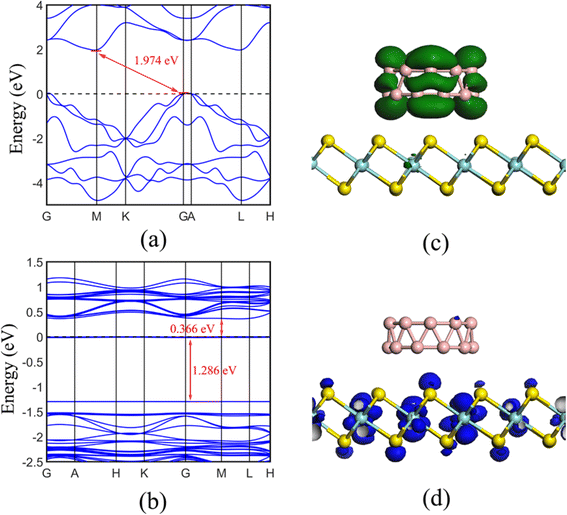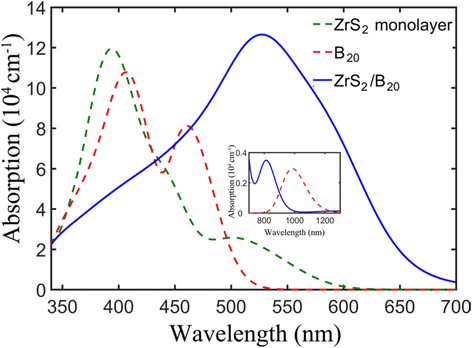Dramatically Enhanced Visible Light Response of Monolayer ZrS2 via Non-covalent Modification by Double-Ring Tubular B20 Cluster
- PMID: 27832524
- PMCID: PMC5104703
- DOI: 10.1186/s11671-016-1719-8
Dramatically Enhanced Visible Light Response of Monolayer ZrS2 via Non-covalent Modification by Double-Ring Tubular B20 Cluster
Abstract
The ability to strongly absorb light is central to solar energy conversion. We demonstrate here that the hybrid of monolayer ZrS2 and double-ring tubular B20 cluster exhibits dramatically enhanced light absorption in the entire visible spectrum. The unique near-gap electronic structure and large built-in potential at the interface will lead to the robust separation of photoexcited charge carriers in the hybrid. Interestingly, some Zr and S atoms, which are catalytically inert in isolated monolayer ZrS2, turn into catalytic active sites. The dramatically enhanced absorption in the entire visible light makes the ZrS2/B20 hybrid having great applications in photocatalysis or photodetection.
Keywords: Electronic structure; Enhanced visible-light response; First-principles; ZrS2/B20 hybrid.
Figures





Similar articles
-
First-principles study on the electronic structure and photocatalytic property of a novel two-dimensional ZrS2/InSe heterojunction.RSC Adv. 2023 Apr 11;13(16):11150-11159. doi: 10.1039/d2ra08000a. eCollection 2023 Apr 3. RSC Adv. 2023. PMID: 37056969 Free PMC article.
-
Strain-tuned mechanical, electronic, and optoelectronic properties of two-dimensional transition metal sulfides ZrS2: a first-principles study.J Mol Model. 2022 Feb 18;28(3):63. doi: 10.1007/s00894-022-05052-8. J Mol Model. 2022. PMID: 35182241
-
Benchmarking the high conductive two-dimensional layered structured NbS2, ZrS2, ReS2 and NbSe2 materials with zero energy bandgap (E g) for photocatalytic application: a DFT study.R Soc Open Sci. 2025 Mar 5;12(3):241560. doi: 10.1098/rsos.241560. eCollection 2025 Mar. R Soc Open Sci. 2025. PMID: 40061220 Free PMC article.
-
Non-covalent functionalization of WS2 monolayer with small fullerenes: tuning electronic properties and photoactivity.Dalton Trans. 2016 Sep 14;45(34):13383-91. doi: 10.1039/c6dt02074g. Epub 2016 Aug 2. Dalton Trans. 2016. PMID: 27483028
-
Unique physicochemical properties of two-dimensional light absorbers facilitating photocatalysis.Chem Soc Rev. 2018 Aug 13;47(16):6410-6444. doi: 10.1039/c8cs00396c. Chem Soc Rev. 2018. PMID: 30079912 Review.
Cited by
-
First-principles study on the electronic structure and photocatalytic property of a novel two-dimensional ZrS2/InSe heterojunction.RSC Adv. 2023 Apr 11;13(16):11150-11159. doi: 10.1039/d2ra08000a. eCollection 2023 Apr 3. RSC Adv. 2023. PMID: 37056969 Free PMC article.
-
Penta-Graphene as a Potential Gas Sensor for NOx Detection.Nanoscale Res Lett. 2019 Sep 6;14(1):306. doi: 10.1186/s11671-019-3142-4. Nanoscale Res Lett. 2019. PMID: 31493117 Free PMC article.
References
-
- Najmzadeh M, Ko C, Wu K et al. (2016) Multilayer ReS2 lateral p–n homojunction for photoemission and photodetection. Appl Phys Express 9:055201
-
- Mouri S, Miyauchi Y, Matsuda K. Chemical doping modulation of nonlinear photoluminescence properties in monolayer MoS2. Appl Phys Express. 2016;9:055202. doi: 10.7567/APEX.9.055202. - DOI
LinkOut - more resources
Full Text Sources
Other Literature Sources
Miscellaneous

